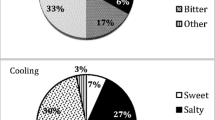Abstract
Introduction
Food choice and habitual diet-related health outcomes are strongly influenced by the oral sensations elicited by food. Of the biological-based mediators of orosensation, thermal tasting—the capacity to experience phantom taste sensations on lingual thermal stimulation—has not been investigated with respect to orosensation and liking of sampled foods.
Methods
Twenty-three female thermal tasters (TTs) and 21 female thermal non-tasters (TnTs) scored liking of (9-point hedonic scale) and the intensity of orosensations elicited by (gVAS) 22 food and beverage items in duplicate using a randomized complete block design in a customized sensory evaluation laboratory. Foods selected included high fat, high sugar, and high salt items. Sampled items were grouped according to the dominant orosensation(s) elicited (sweet, bitter, sour, salty, astringent, creamy, crunchy, crispy, firm, menthol cool, and grainy), and intensity and liking assessed for each group.
Results
No significant differences were found for thermal tasting status (TTS) in intensity ratings of orosensory groupings (p(t) > 0.05). TnTs gave higher liking ratings for creamy foods than TTs (t = 5.99, p = 0.015), and their liking of the “aversive” food grouping was higher than for TTs and approached significance (t = 2.97, p = 0.086).
Conclusions and Implications
The previously reported variation in orosensation due to TTS observed with simple aqueous solutions, and some beverages may not extend to sampled foods. However, differences in liking are suggested for some food groupings and are worthy of further investigation.





Similar content being viewed by others
References
Bajec MR, Pickering GJ (2008) Thermal taste, PROP responsiveness and perception of oral sensations. Physiol Behav 95:581–590
Bajec MR, Pickering GJ (2010) Association of thermal taste and PROP responsiveness with food liking, neophobia, body mass index, and waist circumference. Food Qual Prefer 21:589–601
Bajec MR, Pickering GJ, DeCourville N (2012) Influence of stimulus temperature on orosensory perception and variation with taste phenotype. Chemosens Percept 5:243–265
Cruz A, Green BG (2000) Thermal stimulation of taste. Nature 403:889–892
Duffy (2007) Variation in oral sensation: implications for diet and health. Curr Opin Gastroenterol 23(2):171–177
Duffy, V. B., Hayes, J. E., Sullivan, B. S., and Faghri, P. (2009). Surveying food and beverage liking: A tool for epidemiological studies to connect chemosensation with health outcomes. Annals of the New York Academy of Sciences, 1170, International Symposium on Olfaction and Taste, 558–568, July 2009.
Feeney E, O’Brien A, Scannell A, Markey E, Gibney R (2011) Genetic variation in taste perception: does it have a role in healthy eating? Proc Nutr Soc 70(1):135–143
Garcia-Bailo B, Toguri C, Eny KM, El-Sohemy A (2009) Genetic variation in taste and its influence on food selection. J Integr Biol 13:69–80
Gaudette NJ, Pickering GJ (2013) Modifying bitterness in functional food systems. Crit Rev Food Sci Nutr 53:464–481
Green BG, George P (2004) Thermal taste predicts higher responsiveness to chemical taste and flavour. Chem Senses 29:617–628
Hayes, J. (2015). Measuring sensory perception in relation to consumer behavior. IN J. Delarue, B. Lawlor and M. Rogeaux (eds). Rapid sensory profiling techniques. Applications in new product development and consumer research. Woodhead Publishing Series in Food Science, Technology and Nutrition
Hayes J, Duffy VB (2008) Oral sensory phenotype identifies level of sugar and fat required for maximal liking. Physiol Behav 95:77–87
Hayes J, Keast RSJ (2011) Two decades of supertasting: where do we stand? Physiol Behav 104:1072–1074
Lucas, S. (2011). Thermal taste and perception of oral sensations elicited by food and beverage products. B.Sc. Thesis. Brock University, Ontario, Canada
Macfie H, Bratchell N, Greenhoff K, Vallis LV (1989) Designs to balance the effect order of presentation and first-order carry-over effects in hall tests. J Sens Stud 4:129–148
Michon C, O’Sullivan MG, Delahunty CM, Kerry JP (2009) The investigation of gender-related sensitivity differences in food perception. J Sens Stud 24:922–937
Pickering GJ, Kvas R (2016) Thermal tasting and difference thresholds for prototypical tastes in wine. Chemosens Percept. doi:10.1007/s12078-0
Pickering GJ, Bartolini A, Bajec MR (2010a) Perception of beer flavour associates with thermal taster status. J Int Brew 116:239–244
Pickering GJ, Moyes A, Bajec MR, Decourville N (2010b) Thermal taster status associates with oral sensations elicited by wine. Aust J Grape Wine Res 16:361–367
Sergi G, Bano G, Pizzato S, Veronese N, Manzato E (2016) Taste loss in the elderly: possible implications for dietary habits. Crit Rev Food Sci Nutr. doi:10.1080/10408398.2016.1160208
Talavera K, Yashumatsu K, Voets T, Droogmans G, Shigemura N, Ninomiya Y, Margolskee RF, Nilius B (2005) Heat activation of TRPM5 underlies thermal sensitivity of sweet taste. Nature 438:1022–1025
Tepper BJ (2008) Nutritional implications of genetic taste variation: the role of PROP sensitivity and other taste phenotypes. Annu Rev Nutr 28:367–388
Tepper BJ, Ullrich NV (2002) Influence of genetic taste sensitivity to 6-npropylthiouracil (PROP), dietary restraint and disinhibition on body mass index in middle-aged women. Physiol Behav 75:305–312
Yang Q, Hollowood T, Hort J (2014) Phenotypic variation in oronasal perception and the relative effects of PROP and thermal taster status. Food Qual Prefer 38:83–91
Acknowledgments
This study was funded by a Discovery Grant from the Natural Sciences and Engineering Research Council of Canada to GP.
Author information
Authors and Affiliations
Corresponding author
Ethics declarations
Conflict of Interest
The authors declare that they have no conflict of interest.
Ethical Approval
All procedures followed were in accordance with the ethical standards of the Brock University Research Ethics Board (File # 12–116) and with the Helsinki Declaration of 1975, as revised in 2008 (5).
Informed Consent
Informed consent was obtained from all patients for being included in the study.
Rights and permissions
About this article
Cite this article
Pickering, G.J., Klodnicki, C.E. Does Liking and Orosensation Intensity Elicited by Sampled Foods Vary with Thermal Tasting?. Chem. Percept. 9, 47–55 (2016). https://doi.org/10.1007/s12078-016-9207-1
Received:
Accepted:
Published:
Issue Date:
DOI: https://doi.org/10.1007/s12078-016-9207-1




